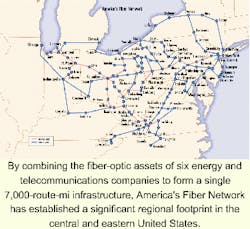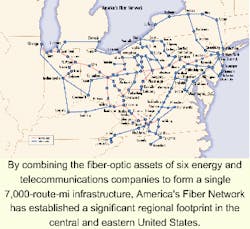Energy and communications partners target fiber to under-served markets
Six energy and telecommunications companies announced the creation of a new super-regional, high-speed fiber-optic network focused on providing bundled communications services to under-served markets. America's Fiber Network LLC (AFN) combines the assets of six operating fiber networks to form a single eastern and central U.S. footprint of more than 7,000 route-mi, or 140,000 fiber-mi.
AFN was formed in March by AEP Communications, a subsidiary of American Electric Power (Columbus, OH); GPU Telecom, a subsidiary of GPU Inc. (Mor ristown, NJ); Allegheny Communica tions Connect, a subsidiary of Allegheny Energy Inc. (Hagerstown, MD); First Energy Telecom, a subsidiary of First Energy Corp. (Akron, OH); CFW Communications (Waynesboro, VA); and R&R Com muni cations (Daleville, VA). AEP, GPU, and Allegheny are majority owners with nearly 90% of the new company, while First Energy, CFW, and R&B are minority owners.
Combining the operational fiber-optic networks of all six companies gives AFN a substantial northeastern footprint encompassing tier one, two, and three markets. By the end of 2000, the company expects to expand the network to 10,000 route-mi by adding companies with existing fiber, installing new fiber in areas of opportunity, and acquiring or leasing existing fiber from other companies.
"America's Fiber Network is a new company, but it's not a new business," says Pete Thomas, vice president of AEP Communications and interim president of AFN. "We have a vision to provide wholesale services that will enable new technologies to be deployed in the second- and third-tier markets. We view ourselves as one of the solutions to the bandwidth divide."
The venture not only combines networks but customers, as well, assigning existing customer contracts into the AFN network. Thomas believes the customers currently served by the six companies will benefit from having a single point of contact and being able to leverage a much larger footprint. Unlike other ventures that are announcing plans to just build networks, says Thomas, AFN is a separate and new business.
"We're not merely interconnecting networks with each party marketing on their own," says Thomas. "We each have contributed assets, and we're on an extensive nationwide search for a chief executive officer to build a single, large-business entity."
AFN's potential success in competing for tier-two and tier-three markets is uncertain at best. According to a report on the company by Current Analysis, a market strategy and analysis firm in Sterling, VA, there are still lots of uncertainties that, depending on how they are dealt with, may be the yardstick for future success.
In AFN's favor, says the report, are six energy companies with deep pockets and ample funds for further network development as well as the development of voice and data services. With 7,000 route-mi of largely dark fiber at its disposal and plans to install more by the end of 2000, AFN's network will rival those of many more established competitors by year's end.
"Courtesy of its energy companies, AFN already has the requisite rights of way for its network expansion," says Chris Nicoll, author of the Current Analysis report. "Other utility-backed telco efforts, such as Qwest and Williams, have been extremely successful with entry strategies similar to AFN's. Additionally, AFN has already managed to sign up MCI WorldCom and Sprint as wholesale transport customers."But before drawing too many comparisons to the likes of Williams Com munications and Qwest Communi cations, there have also been others with similar strategy and similar roots that have yet to make a splash in the industry. Nicoll points out the Columbia Transcom venture of the Columbia Energy Group, which embarked on a similar crusade but has not significantly impacted the telecommunications market in the northeastern United States to date. AFN also faces some obstacles on its road to reap success from the under-served markets. The search for leadership to round out its management team and the need to market a service portfolio are concerns Nicoll sees in AFN's future.
"Despite the deep pockets of its energy-company backers, AFN has no experience in the telecommunications industry and its brand has no 'carry-over' equity from the energy sector," says Nicoll. "The transport and service markets are becoming crowded and AFN lacks a unique and compelling value proposition. But there's an upside, too. AFN's significantly larger network will swamp other small energy-backed telco efforts, unless they can move quickly to build a value proposition and customer base before AFN begins marketing in earnest."
According to Thomas, AFN has currently committed to covering 35% of the U.S. market, primarily the tier-two and tier-three sectors. By connecting them into the larger tier-one city hubs, the company hopes to bring the major metropolitan services, particularly data services, down to the under-served areas.
"There are no NFL or NBA teams looking at serving any of the markets we're interested in," says Thomas. "Of the nation's Internet users, the vast majority are concentrated in the major [tier-one] markets. The reason is that they have access to higher-speed services. We're focusing on providing that same type of access with the same choice or alternatives. We're providing the ability for major retail players to begin servicing these second- and third-tier markets in the same robust way they have attacked the major markets."
AFN is still in the early emerging phase of its development with an ambitious plan to expand the network. It would be advisable for any incumbent local-exchange carriers within the AFN-served regions to keep a wary eye on the company's progress and marketing strategies.
"We're already reviewing a lot of other growth opportunities that would expand our initial footprint as a super-regional carrier," says Thomas. "We haven't set up any definitive goals that say we'll have a national network by any particular date. On the other hand, we haven't put any limits on it to say it's only going to be a national network."

